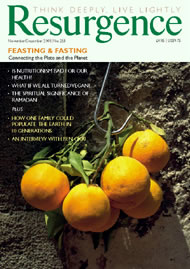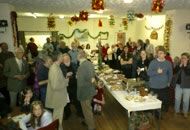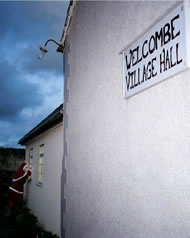IN 1996 I was convener in an attempt to establish a North Devon Community Christmas Festival. The aim was to upstage the prevailing Christmastide that starts in October when rival supermarkets look to be first with the King Wenceslas loop that so activates the consumer’s wallet-finger. The Festival would revive what virtually everyone longed for: a return to some sort of meaning, to genuine and so joyful conviviality, and to being touched by the, or a, or every story of the Midwinter birth of the, or a, or every Miraculous Child.
Was the Festival a failure? The next year the snow on High Street windows was crisp and even with only fifty shopping days to go. But no, not a failure because, after all, the triumph of Christmas resides in small luminous things that happen quite out of the way – like a baby born in the stable, or the cows kneeling at midnight “in the lonely barton by yonder combe, our childhood used to know”.
At a meeting to popularise the festival a woman had asked me, did I know about the Salamongundi? The what? Clearly I didn’t. To be honest, I’m not sure that even now I know much about it; not in general, that is. But in one shining particular I’m very much the authority.
It seems the Salamongundi started not very promisingly in the 17th century in France, and was a bit of a salad. The insubstantiality of this was soon recognised, and so the salad was amplified with a capon. Soon someone tossed in a few anchovies, and then other bits of fish. Before long Salamongundi was just a mix, and when that was self-evidently sufficiently disgusting, the components (this is what I surmise) were set apart and each began to feature individually on the dining board. By the standard process of colonisation this inspired concept moved to the New World where, some would say predictably, it was corrupted and became Solomon Grundy (the esoteric level of the famous rhyme probably reminded pilgrims that, kept for a week, the left-overs must prove deadly). Now of course it began to cater for the larger appetite. The Salamongundi had become a veritable feast. And it’s this that the woman, Mrs Weston, was pointing out. A Festival without a Feast? She was right: it was inconceivable.
Like most recent converts, I was visited by a messianic fervour. There was the keynote: the Salamongundi would feature across the region in church hall and hamlet and farmstead. The name itself was redolent with… Actually, I’m not sure that it was. When I tried to sell it to festival activists I was met with silence whose only reference to Christmas was a wordless “In the bleak mid-winter…” Finally ambition was brought down to just the one village. My own, the village of Welcombe.
“What’s special about it then?” I was asked by the Village Hall Committee.
I told them what Mrs Weston had told me. “Everyone eats what, how and when they wish. Even the children – they can go straight to the puds if they like.”
“And who does the cooking?”
“Everyone,” I said. I had to say something. “Everyone’s invited to come with a gift of their own special, favourite delight.”
Posters went up and a flyer was sent to each house in the Parish. A picture of a table well-laden, and beside it a concoction I devised myself:
The Welcombe Salamongundi
A Great Table is prepared, to which all are invited, and to which all should bring as contribution to the meal a little more than they themselves can eat of home-made fare. Of pies or pickles or preserves, or pasties or puddings. Cakes and cordials and confectionery (and crackers). Of cold roast meat, or home-cured hams. Of nuts and fruit and home-brewed ale. Salads and syllabubs from old secret recipes. And ‘giggly butter’ and cranberry jelly, and ‘Jane jumping jelly’. And fudge. And good yarns and memories. And mistletoe and mince pies… and don’t forget Mother. And then when Grace is well-said, you eat what you please.
WELCOMBE IS A village of 150 independent people whose dwellings are mostly off the map and unimpressed by the concept of immediate neighbours. So how did it happen? Some 120 people came, and found the hall decorated with holly and ivy and the air pungent with cinnamon and clove. The first to arrive found the table bare – but when it had been laid with their offering and the accumulated offerings of those who came later, why, even the feast at Cana seemed a by-the-way miracle. This was a miracle of devotion – co-ordinated, it appeared, by some æthereal chamberlain to ensure that the 120 contributions would satisfy, in terms of starter, entrée and pudding, the judicious appetite of every consenting man, woman, teenager and little ’un in the parish.
And was it well-noticed in the local Press?
“First, carols led by the ladies of the WI, their chime true and unwearied as the first message of Advent.” (You may have already guessed the identity of the reporter.) “Then disciplinary instruction from the Master of Revels, Mr Rosser, that succeeded only a minute in holding the assembled appetite from the table… A table that not so much groaned as cried for mercy beneath the weight, the range, the kaleidoscope, the intricacies and excellencies and generosities of its dishes. Food for a mere hundred courses, but blendable to a thousand tastes (your reporter achieved two slices of Collaberie tiddy-pasty while the less discerning put their fingers to other pies). The food disappeared into a corporate gleam of satisfaction – and no dish was left bearing a crumb of neglect.
“The quality of the Feast was then severely tested. Accompanied by the brave Vicar Hodgetts on the piano, Messrs Dollimore and Rosser ran backwards and forwards, did something novel with a music-stand, and gave a faultless impression of two lunatics singing very badly.
“Proof of this Adventide pudding was the good cheer that had folk linger a warm while after the show and make seasonal charm of clearing up – and still be conversing on their way to their cars beneath the silent clangour and encompassing mystery of the star-shot sky.”
You think the style of this reportage is extravagant? This is because you were never exposed to the event. But what’s actually strange is that that’s the report not of the first but of the fifth Welcombe Salamongundi. The Christmas Festival is long forgotten, and there are now bigger and more supermarkets to promote the Christmas jingle out of town. But down this stretch of lanes the sky is home to real stars, and come the first week in December the Village still gathers for an undated, hand-and-homemade feast.
In the year 2000 the Village came up with The Welcombe Millennium Book featuring every person, the 150 or so, in the Parish. Right at the end there is this afterword:
“How does a scattered village like ours, spread out up and down steep valleys, of long-time locals and recent incomers, farmers and business people, old and young – how does a village like ours become a community?
“One answer – the Salamongundi.”









